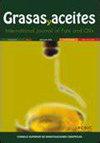Variation in seed morphology and selected oil parameters of neem (Azadirachta indica A. Juss.) from different agroclimatic zones in Tamil Nadu, India
IF 1.1
4区 农林科学
Q4 CHEMISTRY, APPLIED
引用次数: 0
Abstract
Tamil Nadu, in southern India, has the second-largest number of neem trees in the country. The oil from the seeds has high economic significance for cottage industries in the region. This paper examines 28 Candidate Plus Trees (CPTs) selected from six agroclimatic zones in Tamil Nadu which exhibit exceptional traits such as superior growth and other desirable characteristics. We aimed to understand seed morphology variations and physicochemical properties in the oil across different regions. Significant differences were observed for morphometric traits. Fruit production correlated negatively with rainfall. 100-seed kernel weight and seed length correlated with oil percentage. Rainfall influenced seed breadth and pericarp weight. Clustering using morphological characters did not group genotypes from the same region; while soil type could distinguish them. Correlation helped us determine the prominent features which influence the traits of interest, which can be useful for breeding programs, cultivation practices, and the development of neem-based products in Tamil Nadu and beyond.印度泰米尔纳德邦不同农业气候区印楝(Azadirachta indica A. Juss.)种子形态和部分油脂参数的变化
印度南部的泰米尔纳德邦拥有印度第二多的楝树。种子榨出的油对该地区的家庭工业具有很高的经济价值。本文研究了从泰米尔纳德邦六个农业气候区选出的 28 个候选加号树种(CPTs),这些树种表现出了优异的性状,如卓越的生长和其他理想特性。我们旨在了解不同地区的种子形态变化和油脂的理化特性。在形态特征方面观察到了显著差异。果实产量与降雨量呈负相关。100 粒种子仁重和种子长度与含油率相关。降雨量影响种子宽度和果皮重量。利用形态特征进行聚类并不能将来自同一地区的基因型归为一类;而土壤类型则可以将它们区分开来。相关性帮助我们确定了影响相关性状的突出特征,这对泰米尔纳德邦及其他地区的育种计划、栽培实践和印楝产品的开发非常有用。
本文章由计算机程序翻译,如有差异,请以英文原文为准。
求助全文
约1分钟内获得全文
求助全文
来源期刊

Grasas y Aceites
工程技术-食品科技
CiteScore
2.50
自引率
0.00%
发文量
50
审稿时长
3 months
期刊介绍:
Grasas y Aceites is a peer-reviewed journal devoted to the publication of original articles concerning the broad field of lipids, especially edible fats and oils from different origins, including non acyl lipids from microbial origin relevant to the food industry. It publishes full research articles, research notes, reviews as well as information on references, patents, and books.
Grasas y Aceites publishes original articles on basic or practical research, as well as review articles on lipid related topics in food science and technology, biology, (bio)chemistry, medical science, nutrition, (bio)technology, processing and engineering. Topics at the interface of basic research and applications are encouraged. Manuscripts related to by-products from the oil industry and the handling and treatment of the wastewaters are also welcomed.
Topics of special interest to Grasas y Aceites are:
-Lipid analysis, including sensory analysis
-Oleochemistry, including lipase modified lipids
-Biochemistry and molecular biology of lipids, including genetically modified oil crops and micro-organisms
-Lipids in health and disease, including functional foods and clinical studies
-Technical aspects of oil extraction and refining
-Processing and storage of oleaginous fruit, especially olive pickling
-Agricultural practices in oil crops, when affecting oil yield or quality
 求助内容:
求助内容: 应助结果提醒方式:
应助结果提醒方式:


